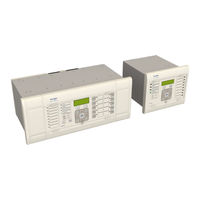GE P444 Manuals
Manuals and User Guides for GE P444. We have 1 GE P444 manual available for free PDF download: Technical Manual
GE P444 Technical Manual (623 pages)
Brand: GE
|
Category: Protection Device
|
Size: 10.8 MB
Table of Contents
-
Contents3
-
-
Environment14
-
Contents19
-
-
Power Supply31
-
Ratings31
-
Type Tests32
-
Dnp3.045
-
Front Panel53
-
PSL Editor71
-
S&R Courier71
-
Aedr272
-
Wavewin72
-
Winaedr272
-
Settings79
-
CT and VT Ratio117
-
Introduction159
-
Fault Modelling168
-
Confirmation174
-
Phase Selection174
-
Tripping Logic179
-
Logic Diagram180
-
Fault Locator181
-
Line Setting186
-
Zone Setting186
-
Zone Setting – Z193
-
Fault Locator196
-
Standard Scheme198
-
Trip Mode208
-
Power Swing223
-
Line Impedance224
-
Relay Settings224
-
System Data224
-
Power Swing Band226
-
-
Biphase Loop240
-
Time Delay VTS247
-
DEF Calculation258
-
Typical Settings269
-
Lockout Reset274
-
CT and VT Ratio279
-
CT Ratios279
-
VT Ratios280
-
Modem Connection284
-
DDB ‘LED 1 Red’288
-
Supervision288
-
VTS Description289
-
VTS Logic292
-
Autorecloser302
-
De-Ionising Time305
-
Reclaim Time306
-
CB Discrepancy310
-
Logic Diagrams312
-
Types of Event393
-
Fault Records395
-
General Events395
-
Measurements400
-
Firmware Design403
-
Hardware Modules411
-
Processor Board411
-
Input Board412
-
Input Module412
-
Main Input Board413
-
Relay Software418
-
Record Logging419
-
System Boot422
-
Commissioning425
-
Product Checks432
-
External Wiring434
-
Insulation434
-
Auxiliary Supply435
-
Date and Time436
-
Output Relays438
-
RS485 Terminals440
-
Current Inputs441
-
Voltage Inputs442
-
Zones Coverage451
-
Control459
-
Relay Blocking461
-
Relay Unblocking461
-
Perform the Test463
-
On-Load Checks465
-
Final Checks467
-
Maintenance469
-
Alarms473
-
Opto-Isolators473
-
Method of Repair474
-
Replacing a PCB475
-
Recalibration484
-
Battery Disposal485
-
Troubleshooting487
-
Power up Errors493
-
Bus Termination507
-
EIA(RS)485 Bus507
-
Biasing508
-
Legacy Protocols513
-
Working Offline514
-
Courier Protocol515
-
Event Extraction517
-
Event Format518
-
Event Types518
-
MODBUS Functions520
-
Modbus Interface520
-
Response Codes520
-
Manual Selection521
-
Register Mapping521
-
Record Data522
-
-
Data Type G29532
-
Data Type G125533
-
Initialization534
-
Test Mode535
-
Dnp3.0 Interface536
-
DNP3.0 Protocol536
-
Interoperability539
-
The Data Model539
-
Capability540
-
Scope542
-
Loss of Power543
-
Logic Timers554
-
Logic Gates556
-
Installation559
-
Storage565
-
Unpacking566
-
Relay Mounting567
-
Rack Mounting568
-
Blanking Plates569
-
Panel Mounting569
-
Relay Wiring571
-
RS485 Port571
-
Earth Connection572
-
RS232 Port572
-
Standards591
-
Cip 002592
-
Cip 003592
-
NERC Compliance592
-
Cip 004593
-
Cip 005593
-
Cip 006593
-
Cip 007593
-
Cip 008594
-
Cip 009594
-
Ieee 1686-2007594
-
Password Rules596
-
Blank Passwords598
-
Logging out600
-
Port Disablement600
-
Events601
Advertisement
Advertisement
